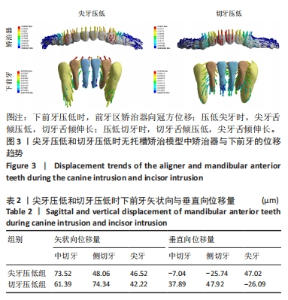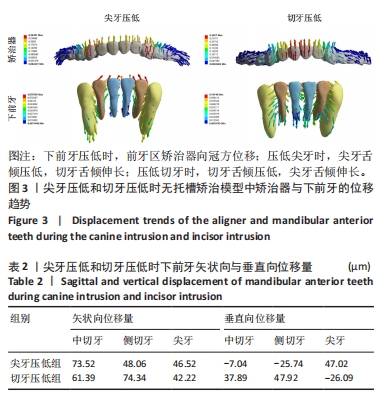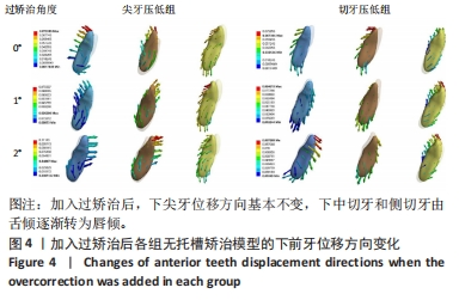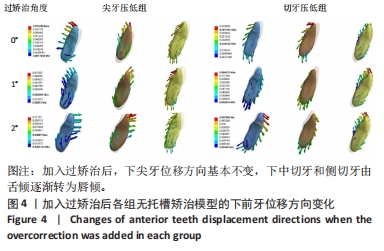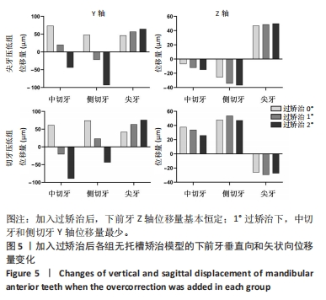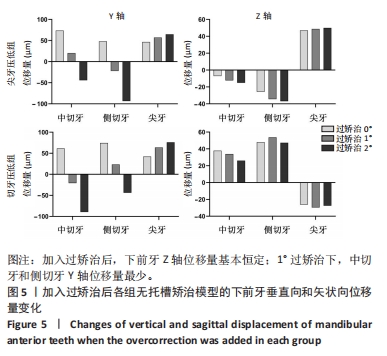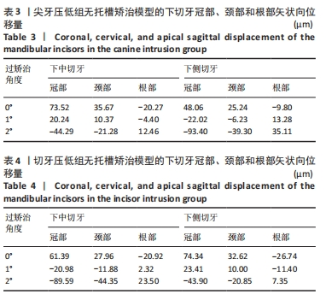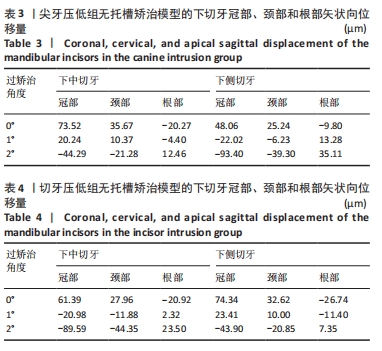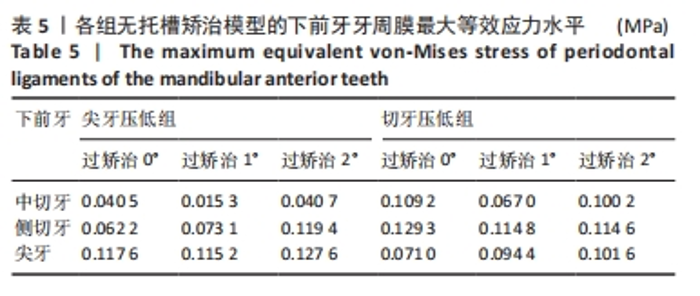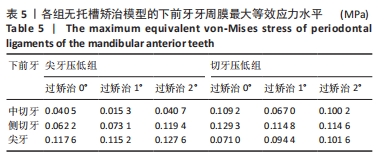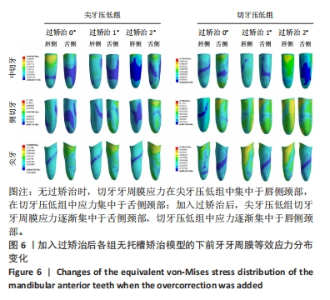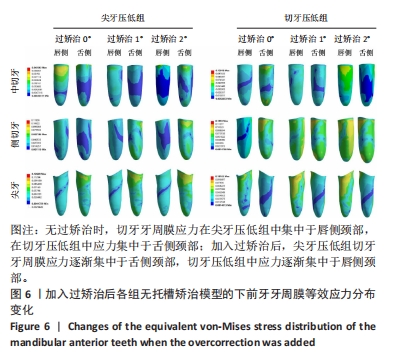Chinese Journal of Tissue Engineering Research ›› 2024, Vol. 28 ›› Issue (29): 4593-4598.doi: 10.12307/2024.565
Effect of sagittal overcorrection design on displacement and stress of mandibular anterior teeth intrusion using clear aligners
Huang Yangyang1, Wang Shiyu1, Liu Hao1, 2, Yang Li1, 2, Wang Penglai1, 3, Yuan Changyong1, 3
- 1School of Stomatology, Xuzhou Medical University, Xuzhou 221000, Jiangsu Province, China; 2Department of Orthodontics, 3Department of Implantology, Affiliated Stomatological Hospital of Xuzhou Medical University, Xuzhou 221000, Jiangsu Province, China
-
Received:2023-10-20Accepted:2023-11-30Online:2024-10-18Published:2024-03-22 -
Contact:Yuan Changyong, Associate professor, Associate chief physician, School of Stomatology, Xuzhou Medical University, Xuzhou 221000, Jiangsu Province, China; Department of Implantology, Affiliated Stomatological Hospital of Xuzhou Medical University, Xuzhou 221000, Jiangsu Province, China -
About author:Huang Yangyang, Master candidate, School of Stomatology, Xuzhou Medical University, Xuzhou 221000, Jiangsu Province, China -
Supported by:Health Commission Science and Technology Project of Xuzhou, No. XWKYHT20220133 (to YL)
CLC Number:
Cite this article
Huang Yangyang, Wang Shiyu, Liu Hao, Yang Li, Wang Penglai, Yuan Changyong. Effect of sagittal overcorrection design on displacement and stress of mandibular anterior teeth intrusion using clear aligners[J]. Chinese Journal of Tissue Engineering Research, 2024, 28(29): 4593-4598.
share this article
Add to citation manager EndNote|Reference Manager|ProCite|BibTeX|RefWorks
| [1] AL-ZOUBI EM, AL-NIMRI KS. A comparative study between the effect of reverse curve of Spee archwires and anterior bite turbos in the treatment of deep overbite cases. Angle Orthod. 2022;92(1):36-44. [2] BARDIDEH E, TAMIZI G, SHAFAEE H, et al. The Effects of Intrusion of Anterior Teeth by Skeletal Anchorage in Deep Bite Patients; A Systematic Review and Meta-Analysis. Biomimetics (Basel). 2023;8(1):101. [3] CHAWSHLI OF, HASAN HS, YALDA FA, et al. The success rate of mini-screws for incisors intrusion and patient age, gender, and insertion angle in the maxilla using CBCT and implant-guided surgery. A split-mouth, randomized control trail. Orthod Craniofac Res. 2023.doi: 10.1111/ocr.12700. [4] ROSSINI G, PARRINI S, CASTROFLORIO T, et al. Efficacy of clear aligners in controlling orthodontic tooth movement: a systematic review. Angle Orthod. 2015;85(5):881-889. [5] SHAHABUDDIN N, KANG J, JEON HH. Predictability of the deep overbite correction using clear aligners. Am J Orthod Dentofacial Orthop. 2023; 163(6):793-801. [6] BLUNDELL HL DR, WEIR T DR, KERR B DR, et al. Predictability of overbite control with the Invisalign appliance. Am J Orthod Dentofacial Orthop. 2021; 160(5):725-731. [7] AL-BALAA M, LI H, MA MOHAMED A, et al. Predicted and actual outcome of anterior intrusion with Invisalign assessed with cone-beam computed tomography. Am J Orthod Dentofacial Orthop. 2021;159(3):e275-e280. [8] GRECO M, ROMBOLÀ A. Precision bite ramps and aligners: An elective choice for deep bite treatment. J Orthod. 2022;49(2):213-220. [9] HENICK D, DAYAN W, DUNFORD R, et al. Effects of Invisalign (G5) with virtual bite ramps for skeletal deep overbite malocclusion correction in adults. Angle Orthod. 2021;91(2):164-170. [10] ROZZI M, TIBERTI G, MUCEDERO M, et al. Leveling the curve of Spee: Comparison between continuous archwire treatment and Invisalign system: A retrospective study. Am J Orthod Dentofacial Orthop. 2022;162(5):645-655. [11] MURO MP, CARACCIOLO ACA, PATEL MP, et al. Effectiveness and predictability of treatment with clear orthodontic aligners: A scoping review. Int Orthod. 2023;21(2):100755. [12] CHARALAMPAKIS O, ILIADI A, UENO H, et al. Accuracy of clear aligners: A retrospective study of patients who needed refinement. Am J Orthod Dentofacial Orthop. 2018;154(1):47-54. [13] PALONE M, PIGNOTTI A, MORIN E, et al. Analysis of overcorrection to be included for planning clear aligner therapy: a retrospective study. Angle Orthod. 2023;93(1):11-18. [14] BILELLO G, FAZIO M, AMATO E, et al. Accuracy evaluation of orthodontic movements with aligners: a prospective observational study. Prog Orthod. 2022;23(1):12. [15] ZHANG Y, GAO J, WANG X, et al. Biomechanical factors in the open gingival embrasure region during the intrusion of mandibular incisors: A new model through finite element analysis. Front Bioeng Biotechnol. 2023;11:1149472. [16] MA Y, LI S. The optimal orthodontic displacement of clear aligner for mild, moderate and severe periodontal conditions: an in vitro study in a periodontally compromised individual using the finite element model. BMC Oral Health. 2021;21(1):109. [17] CAO Y, WANG ZW, CHEN D, et al. The effect of space arrangement between anterior teeth on their retraction with clear aligners in first premolar extraction treatment: a finite element study. Prog Orthod. 2023;24(1):39. [18] LIU X, WU J, CHENG Y, et al. Effective contribution ratio of the molar during sequential distalization using clear aligners and micro-implant anchorage: a finite element study. Prog Orthod. 2023;24(1):35. [19] WANG Q, DAI D, WANG J, et al. Biomechanical analysis of effective mandibular en-masse retraction using Class II elastics with a clear aligner: a finite element study. Prog Orthod. 2022;23(1):23. [20] LIU L, SONG Q, ZHOU J, et al. The effects of aligner overtreatment on torque control and intrusion of incisors for anterior retraction with clear aligners: A finite-element study. Am J Orthod Dentofacial Orthop. 2022;162(1):33-41. [21] YANG Y, YANG R, LIU L, et al. The effects of aligner anchorage preparation on mandibular first molars during premolar-extraction space closure with clear aligners: A finite element study. Am J Orthod Dentofacial Orthop. 2023;164(2):226-238. [22] LIU L, ZHAN Q, ZHOU J, et al. Effectiveness of an anterior mini-screw in achieving incisor intrusion and palatal root torque for anterior retraction with clear aligners. Angle Orthod. 2021;91(6):794-803. [23] CHENG Y, LIU X, CHEN X, et al. The three-dimensional displacement tendency of teeth depending on incisor torque compensation with clear aligners of different thicknesses in cases of extraction: a finite element study. BMC Oral Health. 2022;22(1):499. [24] WANG S, HUANG Y, FAN D, et al. Effects of overtreatment with different attachment positions on maxillary anchorage enhancement with clear aligners: a finite element analysis study. BMC Oral Health. 2023;23(1):693. [25] CHENG Y, GAO J, FANG S, et al. Torque movement of the upper anterior teeth using a clear aligner in cases of extraction: a finite element study. Prog Orthod. 2022;23(1):26. [26] YAO S, JIANG W, WANG C, et al. Improvements of tooth movement efficiency and torque control in expanding the arch with clear aligners: a finite element analysis. Front Bioeng Biotechnol. 2023;11:1120535. [27] GARLOCK DT, BUSCHANG PH, ARAUJO EA, et al. Evaluation of marginal alveolar bone in the anterior mandible with pretreatment and posttreatment computed tomography in nonextraction patients. Am J Orthod Dentofacial Orthop. 2016;149(2):192-201. [28] GUO Z, ZHANG R, GUO C, et al. A retrospective study of alveolar bone remodelling after anterior retraction in orthodontic tooth extraction cases with clear aligners and fixed appliances. Orthod Craniofac Res. 2023. doi: 10.1111/ocr.12705. [29] SADEK MM, GABER RM. Alveolar bone changes around maxillary incisors after intrusion and retraction with controlled tipping versus bodily movement : A retrospective cone-beam computed tomography study. J Orofac Orthop. 2023. doi: 10.1007/s00056-023-00493-z. [30] MORAD G, BEHNIA H, MOTAMEDIAN SR, et al. Thickness of labial alveolar bone overlying healthy maxillary and mandibular anterior teeth. J Craniofac Surg. 2014;25(6):1985-1991. [31] CASANOVA-SARMIENTO JA, ARRIOLA-GUILLÉN LE, RUÍZ-MORA GA, et al. Comparison of anterior mandibular alveolar thickness and height in young adults with different sagittal and vertical skeletal relationships: A CBCT Study. Int Orthod. 2020;18(1):79-88. [32] FORMOSA J, ZOU M, CHUNG CH, et al. Mandibular alveolar bone thickness in untreated Class I subjects with different vertical skeletal patterns: a cone-beam computed tomography study. Angle Orthod. 2023;93(6):683-694. [33] LI Y, XIAO S, JIN Y, et al. Stress and movement trend of lower incisors with different IMPA intruded by clear aligner: a three-dimensional finite element analysis. Prog Orthod. 2023;24(1):5. [34] MOGA RA, BURU SM, CHIOREAN CG. Overall stress in periodontal ligament under orthodontic movement during a periodontal breakdown. Am J Orthod Dentofacial Orthop. 2022;161(2):e127-e135. [35] LIU Y, HU W. Force changes associated with different intrusion strategies for deep-bite correction by clear aligners. Angle Orthod. 2018;88(6):771-778. [36] NUCERA R, DOLCI C, BELLOCCHIO AM, et al. Effects of Composite Attachments on Orthodontic Clear Aligners Therapy: A Systematic Review. Materials (Basel). 2022;15(2):533. [37] 廖乃麒,钱语然,李渊,等.无托槽隐形矫治拔牙病例上切牙压低实现量及其影响因素分析[J].口腔疾病防治,2023,31(10):720-726. [38] WU Y, YU Q, XIA Y, et al. Does mandibular advancement with clear aligners have the same skeletal and dentoalveolar effects as traditional functional appliances? BMC Oral Health. 2023;23(1):65. [39] ZHU Y, HU W, LI S. Force changes associated with differential activation of en-masse retraction and/or intrusion with clear aligners. Korean J Orthod. 2021;51(1):32-42. [40] 康芙嘉,吴聿淼,刘心雨,等.不同前牙唇倾度及内收压低步距下隐形矫治器作用的比较:三维有限元研究[J].口腔医学研究,2023,39(4): 345-349. [41] MAO B, TIAN Y, XIAO Y, et al. The effect of maxillary molar distalization with clear aligner: a 4D finite-element study with staging simulation. Prog Orthod. 2023;24(1):16. |
| [1] | Li Zhifei, Yang Yin, Chen Hualong, Liang Qinqiu, Zhong Yuanming, Zhang Yisheng. Finite element analysis of the correlation between tilt angle of titanium cage and postoperative subsidence of titanium cage after anterior subtotal cervical corpectomy, decompression and fusion [J]. Chinese Journal of Tissue Engineering Research, 2024, 28(9): 1313-1319. |
| [2] | Ouyang Beiping, Ma Xiangyang, Luo Chunshan, Zou Xiaobao, Lu Tingsheng, Chen Qiling. Three-dimensional finite element analysis of a new horizontal screw-screw crosslink in posterior atlantoaxial internal fixation [J]. Chinese Journal of Tissue Engineering Research, 2024, 28(9): 1320-1324. |
| [3] | Liang Cheng, Zhang Linqi, Wang Guan, Li Wen, Duan Ke, Li Zhong, Lu Xiaobo, Zhuo Naiqiang. Finite element and biomechanical analysis of different implants in repair for unilateral unstable pelvic posterior ring injury [J]. Chinese Journal of Tissue Engineering Research, 2024, 28(9): 1336-1341. |
| [4] | Guo Sutong, Feng Dehong, Guo Yu, Wang Ling, Ding Yujian, Liu Yi, Qian Zhengying, Li Mingyang. Construction and finite element analysis of normal and osteoporotic hip models [J]. Chinese Journal of Tissue Engineering Research, 2024, 28(9): 1342-1346. |
| [5] | Yang Junliang, Lu Tan, Xu Biao, Jiang Yaqiong, Wang Fucheng. Three-dimensional finite element analysis of effects of partial anterior cruciate ligament rupture on knee joint stress [J]. Chinese Journal of Tissue Engineering Research, 2024, 28(9): 1347-1353. |
| [6] | Li Chaojie, Gulati•Maitirouzi, Aierxiding•Abulaiti, Zheng Hui, Tu Hudi. Finite element analysis of medial patellofemoral ligament reconstruction at different flexion angles [J]. Chinese Journal of Tissue Engineering Research, 2024, 28(9): 1359-1364. |
| [7] | Xiaheida·Yilaerjiang, Nijiati·Tuerxun, Reyila·Kuerban, Baibujiafu·Yelisi, Chen Xin. Three-dimensional finite element analysis of the distribution pattern of stress in bone tissues with different characteristics [J]. Chinese Journal of Tissue Engineering Research, 2024, 28(8): 1277-1282. |
| [8] | Wang Qiang, Li Shiyun, Xiong Ying, Li Tiantian. Biomechanical changes of the cervical spine in internal fixation with different anterior cervical interbody fusion systems [J]. Chinese Journal of Tissue Engineering Research, 2024, 28(6): 821-826. |
| [9] | Wei Yuanbiao, Lin Zhan, Chen Yanmei, Yang Tenghui, Zhao Xiao, Chen Yangsheng, Zhou Yanhui, Yang Minchao, Huang Feiqi. Finite element analysis of effects of sagittal cervical manipulation on intervertebral disc and facet joints [J]. Chinese Journal of Tissue Engineering Research, 2024, 28(6): 827-832. |
| [10] | Zhang Rui, Wang Kun, Shen Zicong, Mao Lu, Wu Xiaotao. Effects of endoscopic foraminoplasty and laminoplasty on biomechanical properties of intervertebral disc and isthmus [J]. Chinese Journal of Tissue Engineering Research, 2024, 28(6): 833-839. |
| [11] | Kang Zhijie, Cao Zhenhua, Xu Yangyang, Zhang Yunfeng, Jin Feng, Su Baoke, Wang Lidong, Tong Ling, Liu Qinghua, Fang Yuan, Sha Lirong, Liang Liang, Li Mengmeng, Du Yifei, Lin Lin, Wang Haiyan, Li Xiaohe, Li Zhijun. Finite element model establishment and stress analysis of lumbar-sacral intervertebral disc in ankylosing spondylitis [J]. Chinese Journal of Tissue Engineering Research, 2024, 28(6): 840-846. |
| [12] | Zhang Min, Peng Jing, Zhang Qiang, Chen Dewang. Mechanical properties of L3/4 laminar decompression and intervertebral fusion in elderly osteoporosis patients analyzed by finite element method [J]. Chinese Journal of Tissue Engineering Research, 2024, 28(6): 847-851. |
| [13] | Xue Xiaofeng, Wei Yongkang, Qiao Xiaohong, Du Yuyong, Niu Jianjun, Ren Lixin, Yang Huifeng, Zhang Zhimin, Guo Yuan, Chen Weiyi. Finite element analysis of osteoporosis in proximal femur after cannulated screw fixation for femoral neck fracture [J]. Chinese Journal of Tissue Engineering Research, 2024, 28(6): 862-867. |
| [14] | Huang Peizhen, Dong Hang, Cai Qunbin, Lin Ziling, Huang Feng. Finite element analysis of anterograde and retrograde intramedullary nail for different areas of femoral shaft fractures [J]. Chinese Journal of Tissue Engineering Research, 2024, 28(6): 868-872. |
| [15] | Tan Nengxian, Wu Wenzheng, Zheng Churong, Luo Lieliang, Gu Peng, Ouyang Chongzhi, Zheng Xiaohui. Finite element analysis of different fixation methods of partially threaded cannulated screws for treating vertical femoral neck fractures [J]. Chinese Journal of Tissue Engineering Research, 2024, 28(6): 873-878. |
| Viewed | ||||||
|
Full text |
|
|||||
|
Abstract |
|
|||||
